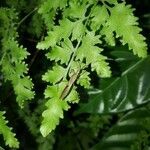Plants terrestrial, 1.2-1.5(-2) m tall. Rhizome creeping, more than 7 mm in diam., glabrescent. Fronds scattered; stipe straw-colored, ca. 50[-70] cm, stiff, usually with dense, short, gray-brown, segmented hairs; rachis and rachillae also straw-colored, with scattered soft hairs. Lamina yellow-green when dried, 3-or 4-pinnate, ovate-oblong in outline, 60-100 × 30-40[-50] cm, thinly papery, both surfaces with often dense, adpressed, slender hairs, base wider, gradually shorter distally, apex acuminate; pinnae 10-15[-20+] pairs, alternate, 10-15 cm apart, spreading obliquely upward, with stalk 1-1.5 cm, bipinnate, broadly lanceolate in outline, lowermost pinnae slightly smaller, largest pinnae 28-30 cm, 10-15 cm wide at base, apex long acuminate; pinnules 15-20 pairs, upswept, parallel with rachis, broadly lanceolate, 2.5-4 × 0.8-1 cm, pinnatisect almost to rachillae, base unequal in width, decurrent, cuneate basiscopically, subtruncate acroscopically, apex acuminate; distal lobes 6-8 pairs, suprabasal ones longer, parallel with rachillae, others oblong, 7-8 × ca. 4 mm, truncate acroscopically, straight-cuneate basiscopically, margin obtusely pinnatifid, apex rounded; lobules entire or apex with 2 or 3 dwarf obtuse teeth. Veins slightly prominent abaxially, pinnately branching. Sori near notch at margin of lobules; indusium brownish, shallowly saucer-or fan-shaped, small, firm, densely hairy.
Rhizome short-creeping, fleshy, with stipes arising in 2 rows. Stipe and rachis chestnut-brown, almost glabrous at base, becoming densely covered in non-glandular hairs at apex; stipe 25–90 cm long, 2–8 mm diam. Lamina 40–175 cm long, 25–120 cm wide, broadly ovate, 3-pinnate at base, with soft dense colourless or brown-tinged hairs on all surfaces, but more abundant towards apex. Primary pinnae in 25–40 pairs, stalked, longest 16–70 cm long, 6–17 cm wide, arising at narrow angles. Secondary pinnae arising at wide angles, longest 3.5–10 cm long, 15–30 mm wide, with winged midribs. Longest tertiary pinnae 10–18 mm long, 6–8 mm wide, divided part-way to midrib; lowest pair unequal in size and angle of attachment. Ultimate pinnules broad, oblong, obtuse. Sori submarginal, with paraphyses, protected by half-cup-shaped indusia. Spores pale, finely echinate or ±smooth.
A large fern. It has creeping rhizomes. These are fleshy. It grows 0.7-2 m high. It forms spreading clumps. The fronds are erect and pale green. They are 0.7-2 m long and the stalks are 30-70 cm long. They are pale brown and hairy. The frond blade is 0.7-1.3 m long by 0.6-1 m wide and they are almost a triangle shape. They are divided 2-4 times. They are dull green. The sori or spore bodies are cup shaped.
Rhizome creeping, set with brown hairs. Veins mostly free. Lamina pinnate to 4-pinnatifid, up to 600 x 210 mm. Sori small, subcircular, opening towards margin, intramarginal, borne on a vein-ending.

